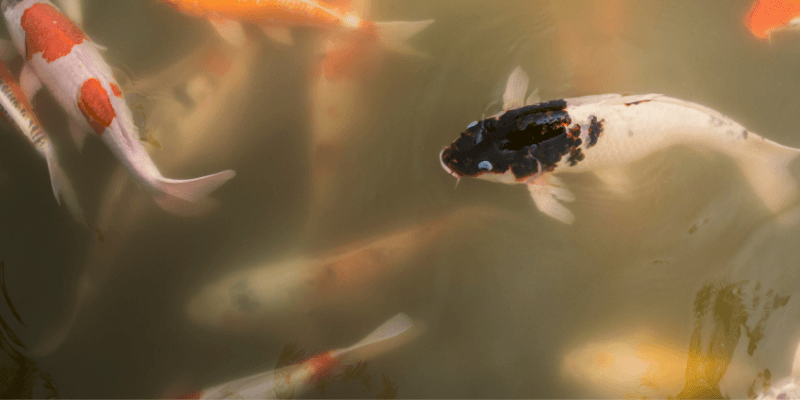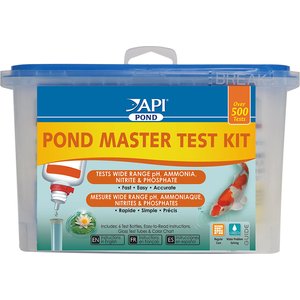How to Clear Murky Pond Water the Right Way (Without Chemicals)
Pond Academy is reader-supported. Buying through links on our site may earn us an affiliate commission. As an Amazon Associate I earn from qualifying purchases.
Murky, cloudy pond water can be a real nuisance for pond owners.
And while it's usually only temporary, it can also be a sign of a bigger problem.
So, lets first identify what might be causing your pond water to appear murky...
And then find out how to quickly clear it up - without using any harmful chemicals.
Don't worry, we'll have your pond back to crystal clear in no time!
What Is Murky Pond Water?

Pond water becomes murkier, muddier, and cloudier as concentrations of suspended organic and inorganic particles increase.
This murkiness is measured as turbidity: the more material is suspended in the water, the greater the pond’s turbidity.
![]() Did you know...
Did you know...
Ponds are more likely to appear murky, cloudy and/or muddy during the warmer, summer months.
Ponds are active environments in the summer months. Fish are aggressively feeding (and pooping). Mud-happy animals like frogs and turtles often stir up debris as they dig along pond bottoms in search of food, and some of this debris remains suspended in the water. Rain showers can also contribute to turbidity by driving dirt from the pond’s edge into the water.
But not all murkiness is so innocent. Algae blooms, for instance, can quickly cause pond water to cloud up, and some blooms are beyond a pond’s ability to control. Newer ponds are especially prone to murkiness as their ecosystems mature.
In most cases, murky or muddy pond water is a far greater aesthetic problem than it is a threat to the pond’s health.
Still, it’s good practice to figure out what is causing the murky water issue to prevent it from happening in the future.
Get Our Best Pond Tips Sent to Your Inbox for Free!
Join thousands of others and learn from our decades of pond building and maintenance experience! Your pond will thank you!
By subscribing you agree to receive emails from PondAcademy.com. We will always respect your privacy and you can unsubscribe at any time.
Why Is My Pond Water Murky?
Before we learn how to clear up murky pond water, lets look at some of the main reasons your pond might be murky in the first place. If we can identify the cause, we can help ensure the murkiness doesn’t come back.
New Ponds
Newer ponds can appear cloudy and murky for months as their ecosystems mature and become established.
And this problem can be compounded by introducing pond fish before your new pond becomes fully established.
This is referred to as "New Pond Syndrome" or NPS.
The best way to tell if your pond is suffering from NPS is 1) if your pond is newer (duh) and 2) if the water is murky and dark green with foam and slime build-up on the walls. Your pond fish will also most likely be suffering which you can tell by them not eating, gasping and potentially even fin and/or gill rot.
Excess Waste & Debris
Excessive levels of organic waste can outstrip the ability of healthy bacteria colonies to keep pond water clear. Poor filtration and the overfeeding of pond fish are the two most common culprits: in particular, fish should never depend entirely on food introduced by humans.
Leaky pond liners can also introduce excessive nutrients to a pond, encouraging rapid growth of algae and other agents of turbidity. If you suspect your pond is leaking, check out our guide on how to find a leak in a pond and get it repaired ASAP.
Inorganic waste, usually in the form of sediment drawn from the soil near the pond’s edge, is yet another cause for cloudy, muddy water. Because precious few pond critters enjoy eating dirt, these particles tend to stick around longer than others; they also tend to arrive in a wider variety of sizes than organic material, including particles so small that most filters simply ignore them.
Algae Growth
If your murky pond water is taking on a green tint, then it's most likely caused by an excessive amount of algae growing in your pond.

As you can see in the picture above, planktonic algae have turned the water a green color with a cloudy consistency. To make matters worse, when the algae die, they contribute to the build-up of sludge in the bottom of your pond.
To complete the triple threat, algae can also affect the PH levels of your pond.
Water Quality Issues
Algae blooms also cause murky pond water indirectly, by raising pH levels. Photosynthesis consumes carbon dioxide, and large blooms of algae can remove enough CO2 to affect the entire pond’s pH level. When pH reaches dangerously high levels, both animals and plants may suffer, upsetting the pond’s self-regulating capacity and leaving more organic material suspended in the water.
Mud & Clay Particles
Mud may enter a pond from its edges or from its bottom; in either case, it doesn’t take much material to temporarily cloud a pond.
Rainwater runoff is the most common vehicle for introducing material from a pond’s edge. Most ponds can handle the effects of heavy rainfalls, even when temporary rivulets bring particles from far beyond the pond’s edge. Similarly, bottom-feeding fish and other animals may disturb the pond’s floor and momentarily cloud the water.
Clay is a different matter. Because clay particles carry identical electrical charges, they repel each other. This dynamic tends to keep clay particles suspended in pond water longer than other bits of earth. Much as we’d like to recommend dropping a gigantic magnet into an affected pond to remove all the clay, the real answer is more mundane: wait for the clay particles to settle out (which they will, eventually), and guard against clay runoff by creating channels that divert rainwater from the pond.
How To Clear Murky & Cloudy Pond Water
Step 1: Test Your Pond’s Water Quality
With so many potential causes, excessive turbidity is often mysterious. Commercially available pond testing kits are a good place to start. They can give pond owners a quick and accurate idea of what’s potentially causing the cloudy pond water, and what might be done about the problem.
Most testing kits measure a range of factors including pH, nitrate levels, ammonia concentrations, and KH.
Ponds that don't support fish usually thrive with pH levels between 6 and 8.5: toward the middle of the scale, and skewing just a bit toward alkalinity. Fish prefer a narrower range of pH, similarly skewed: 7 to 8tends to support most fish species. You can always learn more about how pH affects your pond with our Pond pH guide.
KH, or carbonate hardness, measures carbonate and bicarbonate ions in a pond’s water. Carbonates help to regulate pH, keeping it from swinging too far in one direction or another: low KH levels are a sign of future danger, even in a seemingly healthy pond.
Ammonia is produced in any pond, but healthy ponds dispose of it quickly enough to keep the total concentration near zero. Any significant measure of ammonia points directly to unhealthy conditions in a pond and may cause murky water.
Step 2: Reduce Sludge & Debris
Sludge is simply an accumulation of organic material that has precipitated and settled on a pond’s bottom. Most sludge starts out as leaves that fall to the water’s surface, where they remain for a while before becoming waterlogged, sinking, and decomposing.
Under healthy conditions, oxygenating pond plants and bacteria naturally keep sludge levels in check. When too much sludge accumulates, the excess can contribute to turbidity, and can also be a source of nutrients for unwanted organisms like filamentous algae (aka pond scum).
The best cure for excessive sludge is prevention. Because fallen leaves and other plant material provide most of the grist for sludge, simply keeping the surface debris free with pond netting can keep sludge from reaching problematic levels.
When nets won’t do the trick, dedicated pond skimmers can pull leaves and other sludge precursors out of the water before they decompose.
When preventive measures aren’t enough, sludge can be removed manually, with a pond vacuum, or chemically, with natural sludge removers.
Pond vacuums look and act like the wet/dry vacuums found in wood shops (with an emphasis on the “wet” side of the equation). They make sludge removal an extremely easy process and even come in handy for various other pond cleaning chores.
Pond sludge removers supplement the natural ability of plants and bacteria to break down sludge. They are one of our favorite natural pond cleaner products. But remember that all those little sludge particles will end up in the pond’s filter, so be ready to clean or replace the filter media more frequently.
Another option is to use Aquascape Rapid Clear. This flocculent allows suspended particles in pond water to stick together and sink to the bottom of the pond, where you can then vacuum them out.
If you're in a hurry, this can be a good option, as it only takes 1-3 hours for the product to work. And it's safe for fish!
Check out this video to learn more about how it works.
Sludge is a natural phenomenon, but one major source of excess nutrients may come down to pond owners themselves. Anyone who owns a pond stocked with fish is tempted to overfeed those fish. Trouble is, not even dogfish clean their plates the way dogs do: when fish have had enough to eat, they simply stop eating, leaving excess food to cloud the water and drive the growth of whatever organisms get to it first.
Furthermore, low-quality fish food tends to include fillers that fish can’t digest, and that inevitably make their way into pond water when the digestive process reaches its inevitable conclusion.
So, be sure to only feed your fish what they'll eat (use a pond fish feeder if you need to) and use a high quality fish food so it's properly digested.
Step 3: Improve Your Filtration System
Just as a healthy pond ecosystem disposes of waste materials before they build up, a properly functioning filtration system removes excess particles before they can cause turbidity problems.
Biological filtration systems use beneficial bacteria to break down and dispose of organic waste, and to convert ammonia, which is harmful to pond life in general, into nitrates, which are useful to pond plants.
Poorly functioning biological filters leave organic waste suspended in pond water and allow ammonia to rise. So, if your water test from step 1 showed high ammonia levels, optimizing your filtration system is a good place to start to help bring those levels down.
You can optimize your filtration system by:
- Making sure your pond filter is the right size for your pond and fish load. If you’re unsure, you can use our pond calculator to find the perfect size filter for your pond. Making sure your filter isn’t undersized for your specific pond is crucial to keep your water clean and clear.
- Once you're positive you have the right sized filter, you may want to optimize your biological filter media. Perhaps what you’re currently using isn’t working all too well. Here's what I recommend:
- Extremely murky water may require a supplemental filter with a fine filter medium like poly wool. You may have to replace the poly wool multiple times as it becomes clogged until your pond is clear again. Keep in mind, this could take a few weeks, but it’s extremely effective.
If your pond doesn't have a filtration system, and you have no plans of getting one, it is possible to improve your water quality and clear up any murky water issues. Check out our in-depth guide on how to keep a pond clean without a filter for our step-by-step process. Just keep in mind, it will require a lot more manual work.
Step 4: Algae Control
Free-swimming green algae can begin to cloud the water without being too disruptive. Green water is an acquired taste, but such conditions usually aren’t harmful to aquatic life. When algae does take over, though, the result is a soupy green mass that robs water-dwellers of sunlight, hogs nutrients, and threatens to disrupt pH levels. Keep in mind, I'm not talking about filamentous algae, the stringy type, as they don’t usually make pond water look cloudy or murky.
As intimidating as green algae can be when it overwhelms a pond, cleaning it up is usually simple and straightforward. The best approach here is one of the gentlest: UV clarifiers.
These are devices mounted under the pond’s surface that kill nearby algae with, you guessed it, ultraviolet light. This method is highly effective against unwanted algae while being safe for fish and other pond residents.
“Clarifier” is a somewhat misleading name (I like “Algae-Zapper”): the device only kills algae, leaving the pond’s filtration system to dispose of dead cells before they become problems themselves. This is important to understand because when UV clarifiers are hard at work, you need to pay special attention to your pond filter, and clean or replace filter media as needed.
If algae is a constant nuissance, learn how to get rid of pond algae like a pro!
Important: Before You Try To Clear Murky Pond Water
When ponds cloud up, especially when they remain murky for days or weeks on end, owners naturally want to do what they can to fix the problem.
That instinct, though, might be a problem in and of itself. High turbidity might prevent a pond from looking exactly the way its owner intended, but that doesn’t make it a problem for the pond itself. A healthy pond goes through phases of high turbidity and resolves them naturally, usually to the benefit of plants and animals that call the pond home.
Before reaching for a pond vacuum or investing in an additional filter, it’s advised to take a breath, test the pond’s water, and see if the situation is as biologically dangerous as it is aesthetically unpleasing.
If the water is healthy, the pond’s residents are happy. And if the surface isn’t blanketed with algae or leaves and you're certain your pond isn't suffering from NPS, the biggest challenge may be to resist the temptation to fix what’s not broken.













